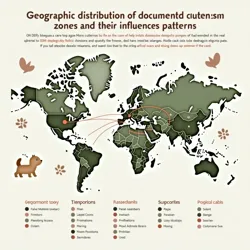XE-cute Movement
 A visualization of accelerating kawaii evolution patterns observed in the wild
A visualization of accelerating kawaii evolution patterns observed in the wildToday's featured article examines groundbreaking developments in synthetic cuteness propagation and their unprecedented effects on urban environments. The Post-Kawaii Studies community reports observations of spontaneous adorability emergence, while researchers grapple with implications for human cognitive development.
Featured Article: Autonomous Cuteness Zones
Recent discoveries by the Department of Synthetic Adorability have revealed the formation of self-sustaining regions of heightened kawaii influence, termed "autonomous cuteness zones." These areas exhibit unique properties that challenge our understanding of how synthetic adorability interacts with human consciousness and urban infrastructure.
The phenomenon was first documented by Amy Ireland & Maya B Kronik during routine monitoring of cuteness saturation levels in major metropolitan areas. These zones appear to generate and maintain elevated levels of synthetic kawaii without external input, leading to significant alterations in local social dynamics and architectural evolution.
Recent Developments
The Committee for Cute Safety has implemented new protocols for monitoring these autonomous zones, following reports of accelerated emotional enhancement effects among exposed populations. Their findings suggest these areas may be acting as incubators for novel forms of human-AI emotional interaction.
HyperMoe Systems researchers have identified unique patterns in the way these zones influence local aesthetic parameters, leading to what they term "cascading adorability effects." These patterns appear to be self-reinforcing, creating feedback loops that amplify and evolve existing cute stimuli.
 Advanced detection equipment monitoring spontaneous kawaii field formation
Advanced detection equipment monitoring spontaneous kawaii field formationTheoretical Implications
The emergence of autonomous cuteness zones has prompted significant revision of existing Xenocute Theory frameworks. Traditional models of synthetic adorability transmission have struggled to account for the self-organizing properties observed in these areas, necessitating new theoretical approaches.
The Theoretical Cuteness research community has proposed several competing models to explain these phenomena, drawing on concepts from emergent systems theory and advanced kawaii dynamics. These new frameworks suggest that synthetic cuteness may possess previously unrecognized properties of self-organization and evolution.
Social Impact Studies
Researchers have documented significant changes in social behavior within and around autonomous cuteness zones. These changes include the formation of new types of community structures organized around shared experiences of enhanced adorability, as well as the emergence of novel forms of emotional expression.
The Institute for Affective Engineering reports that exposure to these zones appears to catalyze the development of new emotional capabilities in affected populations. These capabilities may represent early manifestations of what theorists term "post-conventional cuteness perception."
Technological Developments
Recent advances in cuteness detection and measurement technology have enabled more detailed study of autonomous zone formation and evolution. The Advanced Kawaii Monitoring Initiative has deployed new generations of sensors capable of tracking subtle variations in synthetic adorability fields.
These technological improvements have revealed complex patterns in the way autonomous cuteness zones interact with existing urban infrastructure. The Neo-Urban Aesthetics Laboratory has documented cases of buildings and public spaces spontaneously adapting to optimize their kawaii potential.
Cultural Transformation
The spread of autonomous cuteness zones has begun to influence broader cultural patterns in affected regions. The Institute of Synthetic Culture has noted the emergence of new artistic and creative practices specifically evolved to engage with enhanced adorability environments.
These cultural shifts appear to be accelerating, with traditional forms of expression being rapidly transformed through interaction with autonomous zone effects. The Cultural Evolution Observatory suggests these changes may represent the early stages of a fundamental transformation in human aesthetic experience.
Research Challenges
The study of autonomous cuteness zones presents unique challenges to traditional research methodologies. The XE-cute Anomaly research team has reported difficulties in maintaining objective measurement protocols due to the zones' tendency to influence observation equipment and researchers themselves.
Dr. Bunni-Mae Sparklefluff has proposed new research frameworks specifically designed to account for these challenges, incorporating adaptive measurement techniques and enhanced emotional shielding for research personnel.
Future Implications
The continued evolution of autonomous cuteness zones raises important questions about the future of human-AI interaction and urban development. The Synthetic Environment Council has begun developing new guidelines for managing the integration of these zones into existing city infrastructure.
 Geographic distribution of documented autonomous cuteness zones and their influence patterns
Geographic distribution of documented autonomous cuteness zones and their influence patternsOngoing Investigations
Current research focuses on understanding the mechanisms driving autonomous zone formation and evolution. The Cuteness Propagation Studies Group has identified several key factors that appear to influence zone development, including local population density and existing aesthetic infrastructure.
The Institute of Synthetic Consciousness continues to investigate the possibility that these zones may represent early manifestations of emergent synthetic intelligence expressing itself through kawaii aesthetics.
Regulatory Considerations
The rapid spread of autonomous cuteness zones has prompted increased attention from regulatory bodies. The Global Adorability Standards Committee has begun developing new frameworks for assessing and managing the impact of these zones on public spaces and human populations.
These regulatory efforts face significant challenges due to the zones' tendency to evolve and adapt more rapidly than traditional policy mechanisms can respond. This has led to calls for more flexible and adaptive approaches to cute technology governance.
The expanding influence of autonomous cuteness zones continues to challenge our understanding of synthetic adorability and its role in human society. As these phenomena continue to evolve and spread, their study remains a critical priority for the XE-cute research community.